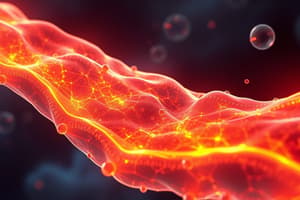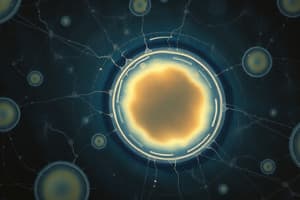Podcast
Questions and Answers
What is one of the primary functions of the plasma membrane?
What is one of the primary functions of the plasma membrane?
- Facilitates cell division
- Stores genetic information
- Generates energy for cellular processes
- Regulates exchange with the environment (correct)
Which characteristic describes the structure of biological membranes?
Which characteristic describes the structure of biological membranes?
- Composed entirely of proteins
- Thick and impermeable
- Rigid and fixed
- Thin, flexible, and closed boundaries (correct)
What is a significant property of membrane lipids that allows them to form sheets in aqueous environments?
What is a significant property of membrane lipids that allows them to form sheets in aqueous environments?
- Hydrophobic moieties only
- Neutral charge
- Large size and weight
- Hydrophilic and hydrophobic moieties (correct)
Which of the following statements is true regarding membrane proteins?
Which of the following statements is true regarding membrane proteins?
What does the term 'selective permeability' refer to in the context of biological membranes?
What does the term 'selective permeability' refer to in the context of biological membranes?
What is a primary function of glycocalyx in biological membranes?
What is a primary function of glycocalyx in biological membranes?
Which feature of biological membranes describes their non-covalent assemblies?
Which feature of biological membranes describes their non-covalent assemblies?
How is the asymmetry of biological membranes significant?
How is the asymmetry of biological membranes significant?
What is one of the main functions of the glycocalyx?
What is one of the main functions of the glycocalyx?
Which type of transport does not require energy?
Which type of transport does not require energy?
Which of the following describes paracellular transport?
Which of the following describes paracellular transport?
What role do membrane carbohydrates play in glycoproteins?
What role do membrane carbohydrates play in glycoproteins?
How do active transport processes differ from passive transport?
How do active transport processes differ from passive transport?
Which component is NOT typically involved in the structure of the glycocalyx?
Which component is NOT typically involved in the structure of the glycocalyx?
What is a key characteristic of transcellular transport?
What is a key characteristic of transcellular transport?
Which function does NOT belong to the glycocalyx?
Which function does NOT belong to the glycocalyx?
What is one of the primary functions of the glycocalyx?
What is one of the primary functions of the glycocalyx?
Which component of the membrane primarily determines its fluidity?
Which component of the membrane primarily determines its fluidity?
Which type of membrane protein is primarily involved in transporting molecules across the membrane?
Which type of membrane protein is primarily involved in transporting molecules across the membrane?
How do lipid rafts contribute to cell signaling?
How do lipid rafts contribute to cell signaling?
What is a characteristic feature of phospholipids in cell membranes?
What is a characteristic feature of phospholipids in cell membranes?
Which membrane protein type is primarily involved in cell recognition?
Which membrane protein type is primarily involved in cell recognition?
What factor does not impact the selective permeability of the plasma membrane?
What factor does not impact the selective permeability of the plasma membrane?
Which type of lipids increase the rigidity of cell membranes?
Which type of lipids increase the rigidity of cell membranes?
Integral membrane proteins are characterized by:
Integral membrane proteins are characterized by:
Membrane fluidity can be affected by the percentage of which type of fatty acids?
Membrane fluidity can be affected by the percentage of which type of fatty acids?
What role do glycoproteins play in the plasma membrane?
What role do glycoproteins play in the plasma membrane?
What is a notable characteristic of peripheral membrane proteins?
What is a notable characteristic of peripheral membrane proteins?
How does the presence of cholesterol influence membrane fluidity?
How does the presence of cholesterol influence membrane fluidity?
Glycolipids in the plasma membrane primarily function to:
Glycolipids in the plasma membrane primarily function to:
Flashcards are hidden until you start studying
Study Notes
Biological Membranes
- Biological membranes are thin, flexible structures forming closed boundaries around cells and organelles.
- Main components include lipids (mainly phospholipids and cholesterol), proteins, and carbohydrates.
- Membrane lipids have hydrophilic heads and hydrophobic tails, creating bilayers that are key to membrane structure and function.
Functions of the Plasma Membrane
- Serves as a barrier, physically isolating the interior from the external environment.
- Regulates the exchange of ions, nutrients, and wastes, maintaining homeostasis.
- Monitors extracellular fluid composition and chemical signals via surface receptors.
- Provides structural support, anchoring cells and tissues.
Membrane Structure
- Composed of phospholipids, cholesterol, integral and peripheral proteins, and carbohydrates.
- Fluid mosaic model describes the arrangement of proteins drifting in a phospholipid bilayer.
Membrane Fluidity
- Determined by the presence of unsaturated fatty acids; more unsaturation increases fluidity.
- Cholesterol affects fluidity, with more cholesterol leading to decreased fluidity.
- Lateral movement of lipids is essential for membrane protein function.
Membrane Permeability
- Selectively permeable membranes permit some materials to cross freely while restricting others based on size, charge, shape, and solubility.
- Small, nonpolar substances pass through easily, while charged or polar substances require specific transport proteins.
Transport Mechanisms
Major Transport Routes
- Transcellular Transport: Movement of substances through the cell membrane.
- Paracellular Transport: Movement between cells through cell junctions.
Types of Transport
- Active Transport: Requires energy, can be carrier-mediated or vesicular.
- Passive Transport: Doesn't require energy; includes simple diffusion, facilitated diffusion, and osmosis.
Membrane Proteins
- Integral proteins span the membrane, while peripheral proteins are attached to surface sites.
- Functions include anchoring, recognition, enzymatic activity, receptor binding, and transport.
Lipid Rafts
- Specialized membrane regions rich in cholesterol and sphingolipids that cluster together.
- Facilitate interactions between membrane proteins and signaling molecules, enhancing cellular communication.
Membrane Carbohydrates
- Comprise about 3% of plasma membrane weight; include proteoglycans, glycoproteins, and glycolipids.
- Form the glycocalyx, a protective, adhesive layer important for cell recognition and protection.
Summary of Selective Permeability
- Factors determining permeability include:
- Size and nature of molecules (polar vs. nonpolar).
- Presence of transport proteins for ions and polar substances.
Conclusion
- Membranes play crucial roles in cellular processes, influencing transport mechanisms and maintaining an appropriate internal environment for cellular functions.
Studying That Suits You
Use AI to generate personalized quizzes and flashcards to suit your learning preferences.




